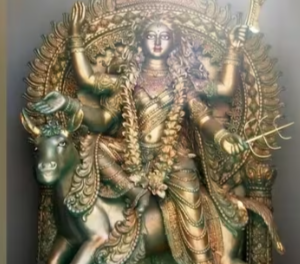During the Navratri festival, devotees worship Navdurga, which represents the nine forms of the goddess Durga, each symbolizing different aspects of her benevolent nature. Shailaputri is linked to the mountains, Chandraghanta is the demon destroyer, Kushmanda embodies the omnipresence of the goddess since the universe’s inception, and Skandamata signifies motherhood. On the seventh day, the goddess assumes the fearsome form of Kalaratri, known for her prowess in subduing demons, evil spirits, and negative energies to offer ultimate protection.
According to ancient tantric texts, Goddess Kalaratri governs the night and is associated with the crown chakra, bestowing worshippers with knowledge, power, and prosperity. Also known as Shubhankari, Raudri, and Dhumorna, Kalaratri is renowned for her formidable appearance, dark complexion, and her mount, the donkey. Adorned with a garland of skulls, she brandishes four hands, two of which hold a thunderbolt and a scimitar, while the others make protective and blessing gestures.
The legend of Maa Kalaratri dates back to the epic battle against the evil forces of Chand, Mund, and Raktabeej. Emerging from the forehead of Maa Chandi, Kalaratri played a pivotal role in annihilating these malevolent entities. To vanquish the demon Raktabeej, who could create clones from his blood, Kalaratri resorted to drinking his blood, ultimately securing victory.
Worshipping Maa Kalaratri is believed to mitigate the adverse impact of planetary influences, fostering joy and granting devotees their desires while eliminating obstacles. Devotees offer jaggery and various cosmetic items as offerings, accompanied by the chanting of the sacred mantra “Om Devi Kalaratryai Namah॥” to invoke her blessings.










